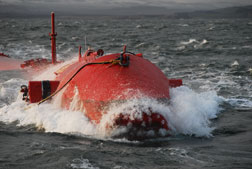...an intertie linking the region to Canada. “With the possibility of a Southeast-to-[British Columbia] intertie, that opens up a whole new market to Canada and the Lower 48,” says Rose.
Alaska Sen. Lisa Murkowski (R) and Washington Rep. Jay Inslee (D) have proposed legislation to fund ocean-energy research. Murkowski says rural Alaskan villages can pay as much as 80¢ per kWh for electricity generated by diesel engines; renewable energy sources could decrease that.
Regulatory Rigors
Almost everyone connected with ocean energy in the U.S. complains about the regulatory process. Bedard calls FERC the “number-one barrier” to ocean-energy development. “By far the biggest challenge is the regulatory regime,” agrees Ron Smith, Verdant Power CEO.
 |
Tidal energy is a new frontier for FERC, so developers must clear the same regulatory hurdles as conventional hydropower, including fish protection, Smith says. But hydroelectric turbines and tidal turbines have huge differences. Verdant is using ultrasonic state-of-the-art technologies to monitor fish passage, says Taylor. “It’s costing us a lot,” about $4 million, adds Smith.
FERC officials say they are responding to the rising interest in ocean energy. Permit applications surged from 11 in 2004-05 to more than 40 in 2006 and four to date this year. FERC has issued 19 preliminary permits this year, says Celeste Miller, a FERC spokeswoman. Such permits give the permittee first priority in applying for a license to build.
In February, FERC announced an interim policy for granting preliminary permits subject to greater scrutiny while it receives comments on alternative approaches to permitting suggested at a technical conference held in December. The comment period expired April 30.
Riding a Wave
 |
The U.K. has taken a leading position in wave-energy development. Wave-device developers are “like the Wright brothers were in the aviation industry,” says Neil Kermode, managing director of the European Marine Energy Center (EMEC), in Scotland. “There is an explosion of public awareness.”
Among developers, Ocean Power Delivery Ltd., Edinburgh, seems closest to commercializing a device. Its Pelamis units are 3.5-m-dia, 140-m-long articulated steel tubes that ride waves to generate 750 kW each. Since 1998, OPD has secured $6 million of U.K. and Scottish government backing and $60 million of private funds, says Max Carcass, business development manager. Under its first commercial contract, OPD this summer will install three Pelamis units for the Portuguese utility Enersis II SGPS S.A. at Peniche, north of Lisbon (ENR 5/22/06 p. 28).
 Ocean Power Delivery Ltd. Pelamis wave-energy generator undergoes sea trials in Scotland’s Orkney Isles before commercial deployment off Portugal.
|
Wave energy is emerging from a “wilderness” period started in the 1980s, believes pioneer Stephen Salter, professor emeritus at Edinburgh University, Scotland. The seminal “nodding duck” device he developed from 1973 foundered through lack of government support and opposition from established energy industries, he says.
But as renewables become fashionable, interest in wave energy has intensified, says Frank Leumann, a manager at Portugal’s Wave Energy Center, Lisbon. Still, funding remains inadequate. “You need huge amounts of investment…you need public support,” he says.
“The critical thing we have been asking is for government to create a feeder market (tariff) for new technologies,” says Carcass. Enhanced tariffs were among measures cited as effective in reducing greenhouse gases by the U.N.’s Intergovernmental Panel on Climate Change’s mitigation proposals, released May 4 in Bangkok.
| + click to enlarge |
 Furgo Oceanor Average Annual Wave Power
|
To promote wave power and attract developers, the U.K. government and Scotland’s regional administration are funding creation of the $30-million EMEC at Stromness, Orkney (ENR 4/7/03 p. 17). EMEC’s wave device area has four test positions in 50 m of water, each with a power line to shore. A fifth is in commissioning. Power lines run to an onshore substation with 11-kV switchgear and into the national grid. For tidal devices, EMEC is completing five grid-linked test areas off Eday Island, 35 kilometers away, in a 2-km-wide channel.
EMEC also has become accredited as an independent verification agency. Kermode hopes the protocols EMEC is developing will become “the standard against which all machines will be tested.” But competition is emerging.
| + click to enlarge |
 South West of England RDA England’s Wave Hub will be a big electric socket for testing wave devices.
|
The Irish Republic’s Sustainable Energy Ireland has established a non-grid connected test area for 1:4 scale devices in Galway Bay, where several machines are or soon will be under trial. A full-scale, grid-linked test area will be set up off the west coast. And last month, the South West of England Regional Development Agency committed financing for a $56-million seabed “Wave Hub,” 18.5 km off Hayle, Cornwall, with a power line to shore (model, left). The scheme is expected to secure approval this summer for installation next year. Four device developers are negotiating to test their devices on the hub, which could send 20 MW of electricity to the region.
Only a few years ago, such projects may not have found sponsors. As rising fuel costs and worries about carbon emissions push new technology, developers hope commercial success follows soon.

Post a comment to this article
Report Abusive Comment